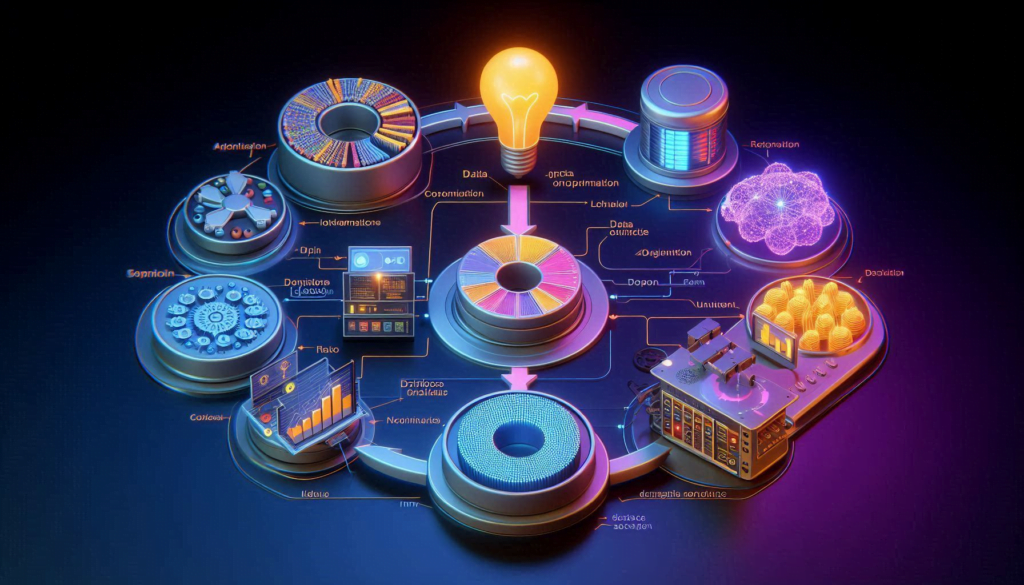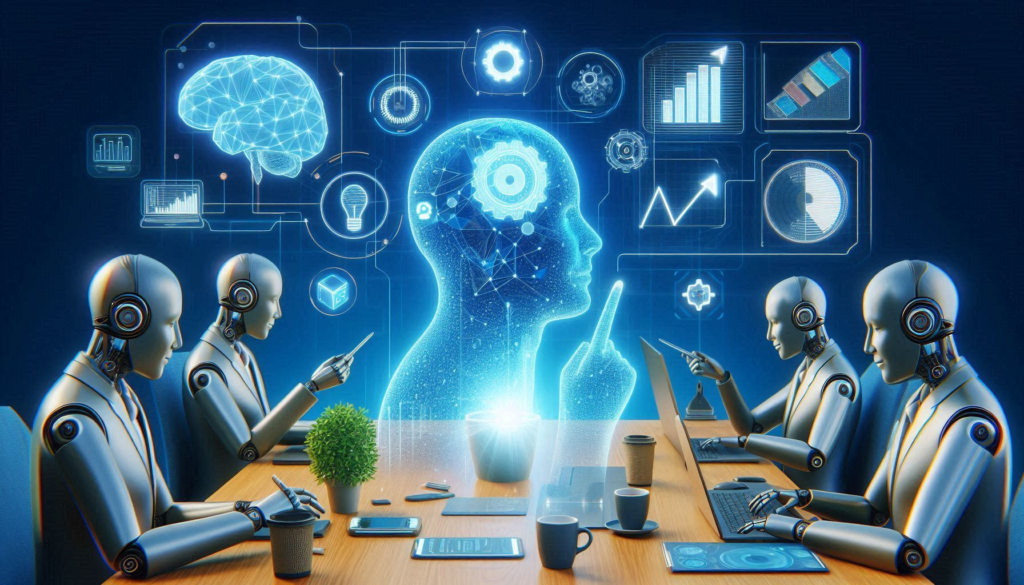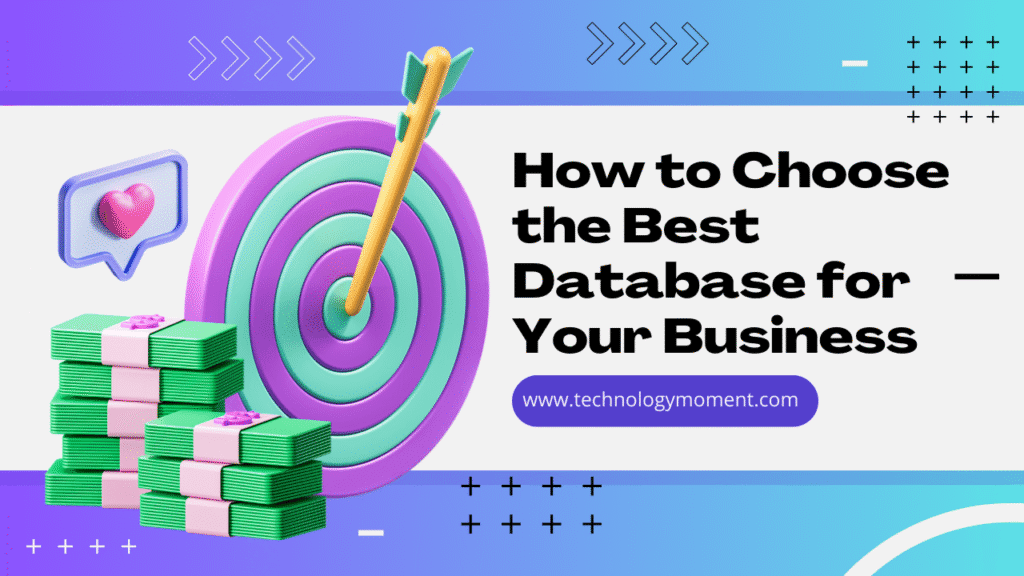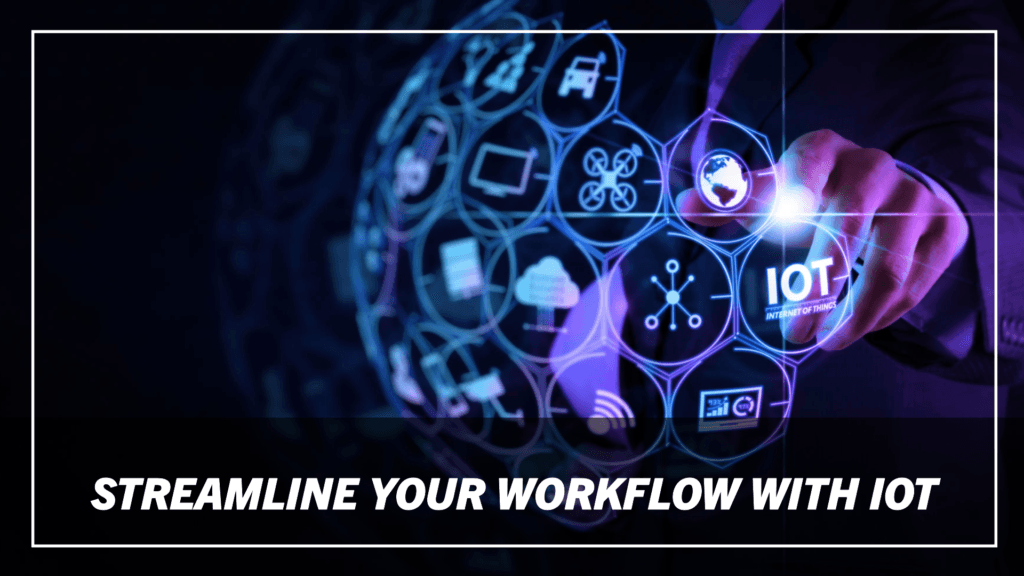In the ever-evolving landscape of education, technology stands as a transformative force, reshaping how we teach and learn. This blog series delves into the pivotal role of instructional technology, exploring its profound impact on classrooms worldwide. From augmented reality to personalized learning platforms, join us on a journey through the digital frontier where innovation meets education, creating new opportunities for students and educators alike. Welcome to a Technology Moment where the future of learning unfolds before our eyes.
Instructional technology refers to the systematic application of technology in the design, development, utilization, management, and evaluation of processes and resources for learning. It’s a broad field that encompasses various tools and techniques aimed at enhancing the learning experience. This includes everything from traditional educational aids like blackboards and textbooks to modern digital tools such as online courses, educational software, and interactive whiteboards.
In essence, instructional technology is about integrating technological advancements into educational settings to facilitate and improve the teaching and learning process. It’s not just about using gadgets but rather about creating an environment where technology serves as a means to achieve educational goals more effectively.
Importance in Modern Education
The significance of instructional technology in today’s educational landscape cannot be overstated. With the rapid advancement of technology and the increasing need for digital literacy, instructional technology plays a crucial role in preparing students for the future.
- Enhanced Engagement and Motivation: Multimedia presentations, educational games, and virtual reality experiences can capture students’ interest and motivate them to participate more actively in their education.
- Personalized Learning: Instructional technology allows for personalized learning experiences tailored to the needs of individual students. Adaptive learning software can adjust the difficulty level of tasks based on a student’s performance, ensuring that each student progresses at their own pace.
- Accessibility and Inclusion: Technology can make education more accessible to students with disabilities. Assistive technologies, such as screen readers and speech-to-text software, help students with visual, auditory, or motor impairments to participate fully in the learning process.
- Collaboration and Communication: Online discussion boards, group projects using collaborative software, and virtual classrooms enable students to work together and learn from each other, regardless of their physical location.
- Preparation for the Future: In a world where technology is ubiquitous, equipping students with the skills to use technological tools is essential. Instructional technology helps students develop digital literacy, critical thinking, and problem-solving skills that are crucial for success in the modern workforce.
- Efficient Assessment and Feedback: Technology enables more efficient and effective assessment of student learning. Teachers can also use data from these assessments to identify areas where students may need additional support.
Table of Contents
Historical Development of Instructional Technology
Instructional technology has a rich and diverse history, marked by significant milestones that have shaped its evolution. Understanding this history provides valuable insights into how modern educational practices and tools have come to be.
Early Beginnings
- Primitive Tools and Oral Traditions: The roots of instructional technology can be traced back to prehistoric times when humans used basic tools and oral traditions to pass down knowledge. Storytelling, drawings, and symbols were among the earliest methods used to convey information and educate others.
- Written Language and Manuscripts: The invention of written language around 3400 BCE in Mesopotamia marked a major advancement. Manuscripts and scrolls became primary means of recording and disseminating knowledge. The Greeks and Romans further refined these methods, using papyrus and parchment.
The Middle Ages and the Renaissance
- Monastic Schools and Universities: During the Middle Ages, monasteries and universities emerged as centers of learning. Monks painstakingly copied manuscripts, preserving and transmitting knowledge. The invention of the printing press by Johannes Gutenberg in the 15th century revolutionized this process, making books more accessible and fostering the spread of ideas.
- The Renaissance: This period saw a renewed interest in science, art, and education. Innovations such as movable type printing and the proliferation of printed materials contributed to a more widespread and systematic approach to education.
The Industrial Revolution
- Mass Education and Standardization: The 18th and 19th centuries brought about the Industrial Revolution, which had a profound impact on education. The need for a literate and skilled workforce led to the establishment of public education systems. Standardized textbooks and instructional materials became common, and educational technology began to take a more formal shape.
- Visual and Audio Aids: The late 19th and early 20th centuries saw the introduction of visual and audio aids in classrooms. Lantern slides, filmstrips, and phonographs were used to enhance learning experiences. These tools marked the beginning of multimedia instruction.
The 20th Century: A Technological Boom
- Radio and Television: The mid-20th century witnessed the advent of radio and television as educational tools. Educational programs and broadcasts became popular, providing new ways to reach and engage students.
- Computer-Assisted Instruction (CAI): The 1960s and 1970s saw the introduction of computers in education. Early computer-assisted instruction programs offered interactive learning experiences and individualized instruction.
- The Internet and Online Learning: The rise of the internet in the late 20th century brought about a revolution in instructional technology. Online learning platforms, virtual classrooms, and digital resources became widely available, providing unprecedented access to information and education.
The 21st Century: A New Era
- Mobile Learning and Apps: The proliferation of smartphones and tablets has further transformed instructional technology. Educational apps and mobile learning platforms allow students to learn anytime, anywhere.
- Artificial Intelligence and Adaptive Learning: Recent advancements in AI and machine learning have led to the development of adaptive learning systems that personalize education based on individual student needs and performance.
- Virtual and Augmented Reality: These technologies are being integrated into educational environments to provide immersive and interactive learning experiences.
Key Components of Instructional Technology
Instructional technology is a broad field encompassing various tools, techniques, and methods aimed at enhancing the educational process. Understanding its key components helps educators and learners make the most of technological advancements. Here’s a detailed breakdown:
1. Hardware
a. Computers and Tablets
- Classroom Computers: Essential for accessing digital resources, running educational software, and connecting to the internet.
- Tablets: Offer portability and versatility, allowing for interactive lessons and mobile learning.
b. Interactive Whiteboards
- Smartboards: Enable teachers to display and interact with digital content dynamically, making lessons more engaging.
- Touchscreens: Allow for direct manipulation of on-screen elements, promoting interactive learning experiences.
c. Audio-Visual Equipment
- Projectors: Useful for displaying multimedia presentations, videos, and other visual aids to a large audience.
- Document Cameras: Allow teachers to project documents, books, or small objects onto a screen, enhancing visual learning.
2. Software
a. Learning Management Systems (LMS)
- Platforms like Moodle, Canvas, and Blackboard: Facilitate course management, content delivery, and student tracking.
- Features: Include grade books, discussion forums, assignment submissions, and feedback mechanisms.
b. Educational Apps and Tools
- Khan Academy, Duolingo, and Google Classroom: Provide interactive lessons, quizzes, and resources tailored to various subjects and levels.
- Specialized Software: Includes tools for subjects like mathematics (e.g., GeoGebra), science simulations (e.g., PhET), and language learning (e.g., Rosetta Stone).
3. Online Resources
a. Digital Libraries and Databases
- Repositories: Such as JSTOR, PubMed, and Google Scholar offer vast amounts of academic articles, research papers, and ebooks.
- Open Educational Resources (OERs): Free and openly licensed educational materials that can be used for teaching, learning, and research.
b. Video Platforms
- YouTube, Vimeo, and TED-Ed: Provide a wealth of educational videos, tutorials, and lectures on various topics.
- Webinars and MOOCs: Online courses and webinars offer opportunities for professional development and self-paced learning.
4. Communication Tools
a. Email and Messaging Platforms
- Google Workspace and Microsoft Teams: Facilitate communication between teachers, students, and parents.
- Class-Specific Platforms: Like Remind and ClassDojo, offer targeted communication and updates.
b. Video Conferencing Tools
- Zoom, Skype, and Microsoft Teams: Enable virtual classrooms, remote teaching, and collaborative learning.
- Features: Include screen sharing, breakout rooms, and interactive whiteboards.
5. Assessment and Feedback Tools
a. Online Quizzes and Exams
- Platforms like Quizlet and Kahoot: Provide interactive quizzes and gamified learning experiences.
- Automated Grading Systems: Help in quick evaluation and feedback, allowing for timely interventions.
b. E-Portfolios
- Digital Portfolios: Allow students to showcase their work and progress over time.
- Assessment Tools: Enable teachers to provide detailed feedback and track student development.
6. Emerging Technologies
a. Artificial Intelligence (AI)
- Personalized Learning: AI-driven platforms like DreamBox and Knewton adapt to individual learning styles and paces.
- Intelligent Tutoring Systems: Provide tailored support and instant feedback to students.
b. Virtual and Augmented Reality (VR/AR)
- Immersive Learning Experiences: Tools like Google Expeditions and Oculus Rift create engaging and interactive environments for subjects like history, science, and geography.
- Simulations and Virtual Labs: Offer hands-on learning experiences in a virtual setting, enhancing understanding and retention.
c. Gamification
- Game-Based Learning: Platforms like Classcraft and Minecraft: Education Edition incorporate game elements to motivate and engage students.
- Educational Games: Provide interactive and enjoyable learning experiences, fostering critical thinking and problem-solving skills.
Benefits of Instructional Technology

Personalized Learning Experiences
Instructional technology allows for personalized learning experiences tailored to individual student needs. With adaptive learning software, students can work at their own pace, receive instant feedback, and engage with content suited to their skill level and learning style. This approach helps cater to diverse learners, ensuring that each student can achieve their full potential.
Enhanced Engagement and Motivation
Interactive multimedia, gamification, and virtual reality are just a few examples of how instructional technology can make learning more engaging and fun. These tools can capture students’ attention, making learning more enjoyable and motivating them to participate actively in their education. By transforming traditional lessons into dynamic experiences, students are more likely to stay interested and retain information.
Improved Collaboration and Communication
Instructional technology facilitates better collaboration and communication among students and teachers. Online discussion boards, collaborative projects using cloud-based tools, and real-time communication platforms enable students to work together, share ideas, and learn from each other, even if they are not physically in the same location. This fosters a sense of community and improves the overall learning experience.
Access to a Wealth of Resources
The internet is a vast repository of knowledge, and instructional technology provides students with easy access to an array of resources. From online libraries and academic journals to educational videos and interactive simulations, students can explore topics in greater depth and from different perspectives. This access to diverse resources enriches the learning experience and encourages independent research and critical thinking.
Flexibility and Convenience
Instructional technology offers flexibility and convenience for both students and teachers. Online courses and digital learning platforms allow for learning to happen anytime, anywhere. Additionally, teachers can leverage technology to create and distribute lesson plans, grade assignments, and provide feedback more efficiently.
Data-Driven Insights
With instructional technology, educators can collect and analyze data on student performance and learning behaviors. This data-driven approach enables teachers to identify areas where students are struggling, adjust instructional strategies, and provide targeted interventions. By using data to inform teaching practices, educators can enhance the effectiveness of their instruction and improve student outcomes.
Cost-Effective Solutions
In many cases, instructional technology can be a cost-effective solution for educational institutions. Digital textbooks, online resources, and virtual labs can reduce the need for physical materials and infrastructure. Additionally, technology can help schools and universities reach more students through online programs, expanding educational opportunities without the need for significant capital investment.
Preparation for the Future
Integrating technology into education helps prepare students for the future workforce. As technology continues to advance, digital literacy and technological skills are becoming increasingly important in almost every field. By familiarizing students with various technologies and teaching them how to use these tools effectively, educators can equip them with the skills they need to succeed in a rapidly changing world.
Inclusivity and Accessibility
Instructional technology can make education more inclusive and accessible for students with disabilities. Assistive technologies, such as screen readers, speech-to-text software, and adaptive keyboards, can help students with physical, sensory, or cognitive impairments participate fully in the learning process. By removing barriers to education, technology ensures that all students have the opportunity to learn and succeed.
Lifelong Learning Opportunities
Instructional technology supports lifelong learning by providing resources and platforms for continuous education. Online courses, webinars, and educational apps enable individuals to pursue new knowledge and skills throughout their lives. This culture of lifelong learning is essential in a world where knowledge and technology are constantly evolving, helping individuals stay relevant and competitive in their careers.
Global Connectivity
Finally, instructional technology connects students and educators from around the world. This global connectivity fosters cross-cultural understanding, collaboration, and the exchange of ideas. Students can participate in virtual exchange programs, collaborate on international projects, and gain a broader perspective on global issues. This interconnectedness enriches the educational experience and prepares students to become global citizens.
Challenges in Implementing Instructional Technology
- Cost and Budget Constraints
- Initial Investment: Implementing instructional technology often requires significant upfront investment in hardware, software, and infrastructure. Schools and educational institutions may struggle to allocate sufficient funds for these initial expenses.
- Ongoing Maintenance: Beyond the initial purchase, there are recurring costs associated with maintaining and updating technological tools and resources. This includes software licenses, hardware repairs, and technical support, which can strain limited budgets.
- Teacher Training and Professional Development
- Lack of Training: Many educators may lack the necessary skills and knowledge to effectively integrate technology into their teaching practices. Comprehensive training programs are essential to equip teachers with the required competencies.
- Resistance to Change: Some educators may be resistant to adopting new technologies, either due to a lack of confidence in their abilities or a preference for traditional teaching methods. Overcoming this resistance requires targeted professional development and support.
- Digital Divide and Equity Issues
- Access to Technology: Not all students have equal access to technology at home, creating a digital divide. This disparity can hinder the effective implementation of instructional technology, as some students may struggle to complete assignments or participate in online activities.
- Socioeconomic Barriers: Students from low-income families may face additional challenges, such as limited access to high-speed internet or personal devices. Ensuring equitable access to technology is crucial for successful implementation.
- Infrastructure and Technical Support
- Inadequate Infrastructure: Schools may lack the necessary infrastructure to support widespread use of instructional technology. This includes reliable internet connectivity, sufficient bandwidth, and modernized classroom setups.
- Technical Issues: Frequent technical problems, such as software glitches or hardware malfunctions, can disrupt the learning process and frustrate both teachers and students. Adequate technical support is essential to address these issues promptly.
- Curriculum Integration
- Alignment with Educational Goals: Effectively integrating technology into the curriculum requires careful planning to ensure it aligns with educational objectives and enhances learning outcomes.
- Content Development: Developing or sourcing high-quality digital content that is engaging and educationally sound is another challenge. This content must be relevant, up-to-date, and tailored to the specific needs of students.
- Student Engagement and Management
- Engagement Levels: While technology can enhance engagement, it can also be a distraction. Teachers need strategies to keep students focused and ensure technology is used to support, rather than detract from, learning.
- Classroom Management: Managing a technology-rich classroom requires new approaches to classroom management. Teachers must balance the use of digital tools with maintaining discipline and ensuring all students are on task.
- Assessment and Evaluation
- Measuring Effectiveness: Assessing the impact of instructional technology on student learning can be challenging. Educators need effective tools and methods to evaluate how technology is improving educational outcomes.
- Data Privacy: With the increased use of digital tools, protecting student data and ensuring privacy is a significant concern.
- Cultural and Attitudinal Barriers
- Cultural Differences: In diverse educational settings, cultural attitudes towards technology can vary widely. Understanding and addressing these differences is essential for successful implementation.
- Attitudinal Shifts: Encouraging a positive attitude towards technology among all stakeholders—students, teachers, parents, and administrators—is critical. This involves highlighting the benefits and demonstrating successful use cases.
Instructional Technology in Different Educational Levels
1. Early Childhood Education
- Interactive Learning Tools: Young children benefit from interactive apps and games designed to teach basic concepts such as numbers, letters, and colors. These tools engage children through playful learning, making education enjoyable and effective.
- Smartboards and Tablets: In classrooms, devices like smartboards and tablets are used to display vibrant visuals and interactive content, fostering an engaging learning environment for young minds.
- Educational TV Programs: Programs tailored for preschoolers, such as “Sesame Street,” use instructional technology to teach social skills, basic math, and language through entertaining and educational content.
2. Primary and Elementary Education
- Educational Software: Programs like ABCmouse and Khan Academy offer interactive lessons in subjects such as math, reading, and science. These platforms allow students to learn at their own pace, reinforcing classroom instruction.
- Gamification: Incorporating game elements into learning, such as earning badges or points for completing tasks, motivates students and makes learning more fun.
- Digital Storytelling: Students use technology to create digital stories, combining text, images, and sound. This not only enhances their literacy skills but also encourages creativity.
3. Secondary Education
- Virtual Laboratories: High school students can perform virtual experiments in subjects like chemistry and biology, allowing for safe and repeatable learning experiences.
- Online Courses and MOOCs: Platforms like Coursera and Khan Academy offer high school-level courses in various subjects, providing supplementary education and advanced learning opportunities.
- Collaboration Tools: Tools such as Google Classroom and Microsoft Teams facilitate group projects and communication, preparing students for collaborative work environments.
4. Higher Education
- Learning Management Systems (LMS): Platforms like Blackboard and Canvas allow for the distribution of course materials, submission of assignments, and communication between students and instructors, streamlining the educational process.
- Virtual Classrooms: Tools like Zoom and Microsoft Teams enable real-time interaction between students and professors, making remote learning feasible and effective.
- Research Tools and Databases: Access to digital libraries and academic databases like JSTOR and PubMed provides students with extensive resources for research and learning.
5. Adult and Continuing Education
- Online Training Programs: Websites like Coursera, Udemy, and LinkedIn Learning offer courses for adults seeking to learn new skills or advance their careers.
- Webinars and Workshops: Professionals can attend online seminars and workshops to stay updated with industry trends and continue their education without leaving their workplace.
- Mobile Learning: Apps like Duolingo and Khan Academy enable adults to learn new languages and skills on the go, making education accessible anytime, anywhere.
6. Special Education
- Assistive Technologies: Tools like speech-to-text software, screen readers, and adaptive keyboards help students with disabilities access and engage with educational content.
- Customizable Learning Tools: Technology allows for personalized learning experiences, adapting content to meet the specific needs of each student.
- Virtual Reality (VR): VR can create immersive learning experiences for students with disabilities, providing a safe environment to practice real-world skills.
Popular Tools and Platforms in Instructional Technology
Instructional technology encompasses a wide range of tools and platforms designed to enhance teaching and learning experiences. These technologies help educators deliver content more effectively, engage students, and improve learning outcomes. Here are some of the most popular tools and platforms used in instructional technology:
Learning Management Systems (LMS)
- Canvas: A versatile LMS that supports online, hybrid, and face-to-face courses. It offers features like assignment submissions, grading, discussion forums, and integration with various third-party tools.
- Moodle: An open-source LMS widely used in educational institutions. It provides a customizable platform with features such as quizzes, grading, forums, and course management.
- Blackboard: A comprehensive LMS that includes tools for course management, student engagement, and assessment. It also offers analytics to track student performance.
Video Conferencing Tools
- Zoom: A popular tool for virtual classrooms and meetings. It supports features like breakout rooms, screen sharing, and recording, making it ideal for remote learning.
- Microsoft Teams: Combines video conferencing with collaboration tools. It integrates with Microsoft Office applications, allowing for seamless communication and teamwork.
- Google Meet: Part of the Google Workspace suite, it offers easy-to-use video conferencing capabilities, including screen sharing and real-time captions.
Interactive Whiteboards
- SMART Board: An interactive whiteboard that allows teachers to display and interact with digital content. It supports touch gestures and can be used for collaborative activities.
- Promethean Board: Another interactive whiteboard solution that provides tools for creating engaging lessons. It integrates with various educational software and resources.
Content Creation Tools
- Camtasia: A screen recording and video editing tool used to create instructional videos and tutorials. It offers features like annotations, transitions, and audio editing.
- Adobe Captivate: A tool for creating eLearning content, including interactive simulations, quizzes, and videos. It supports responsive design for mobile learning.
- Google Slides: A presentation tool that allows educators to create and share multimedia presentations. It supports collaboration and integration with other Google Workspace tools.
Assessment Tools
- Kahoot!: A game-based learning platform used for creating interactive quizzes and surveys. It engages students through competition and real-time feedback.
- Quizlet: A study tool that offers flashcards, quizzes, and games to help students learn and retain information.
- Socrative: An assessment tool that allows teachers to create quizzes, polls, and exit tickets. It provides real-time feedback and analytics to track student understanding.
Collaboration Tools
- Padlet: It supports collaborative brainstorming and project planning.
- Trello: A project management tool used for organizing tasks and collaborating on projects. It uses boards, lists, and cards to keep track of assignments and deadlines.
- Google Docs: A cloud-based word processing tool that allows multiple users to collaborate on documents in real time. It supports comments, suggestions, and version history.
Adaptive Learning Platforms
- Khan Academy: An educational platform that offers personalized learning paths based on student performance. It provides video lessons, practice exercises, and progress tracking.
- DreamBox: An adaptive math platform that adjusts the difficulty of problems based on student responses. It offers real-time feedback and personalized instruction.
- Coursera: It provides adaptive learning paths and interactive assessments.
Virtual and Augmented Reality
- Google Expeditions: A virtual reality tool that allows students to take virtual field trips. It provides immersive experiences that enhance learning and engagement.
- Nearpod VR: An interactive classroom tool that integrates virtual reality experiences into lessons. It supports student participation and real-time feedback.
- zSpace: A platform that combines virtual and augmented reality for interactive learning experiences. It offers hands-on simulations and 3D models.
The Role of Teachers in Instructional Technology
Instructional technology has revolutionized the educational landscape, but the role of teachers remains crucial in this new paradigm. Here’s a detailed explanation of how teachers fit into the world of instructional technology:

Facilitators of Learning
Teachers are no longer just sources of information; they are facilitators of learning. With instructional technology, their role shifts from being the “sage on the stage” to the “guide on the side.” They help students navigate through various technological tools and resources, encouraging self-directed learning and critical thinking.
Integrating Technology into Curriculum
One of the key responsibilities of teachers is to integrate technology into the curriculum effectively. This involves selecting appropriate technological tools that align with learning objectives and enhancing traditional teaching methods. Teachers must stay updated with the latest technological advancements and understand how to apply them to meet educational goals.
Personalizing Learning Experiences
Instructional technology allows for personalized learning experiences, catering to the individual needs of students. Teachers can use data-driven insights to tailor instruction to each student’s strengths and weaknesses. This personalized approach helps in addressing diverse learning styles and paces, making education more inclusive and effective.
Encouraging Collaboration and Engagement
Technology in the classroom can foster collaboration and engagement among students. Teachers play a pivotal role in designing activities that utilize digital tools for group projects, discussions, and interactive learning. By leveraging platforms such as virtual classrooms, discussion boards, and collaborative software, teachers can create a more dynamic and engaging learning environment.
Enhancing Assessment and Feedback
Teachers use instructional technology to improve assessment methods and provide timely feedback. Digital tools enable more frequent and varied assessments, such as quizzes, interactive assignments, and real-time polls. These tools also facilitate immediate feedback, allowing students to understand their progress and areas for improvement promptly.
Professional Development and Continuous Learning
To effectively integrate instructional technology, teachers must engage in continuous professional development. This includes attending workshops, participating in online courses, and collaborating with peers to share best practices. Staying informed about new technologies and pedagogical strategies is essential for teachers to remain effective in a technology-enhanced educational environment.
Ethical and Responsible Use of Technology
Teachers also have a responsibility to ensure the ethical and responsible use of technology in the classroom. This involves teaching students about digital citizenship, online safety, and the ethical implications of using technology. Teachers must model appropriate behavior and set guidelines to help students navigate the digital world responsibly.
Bridging the Digital Divide
Not all students have equal access to technology, and teachers play a crucial role in bridging this digital divide. They need to be aware of students’ varying levels of access to technology and find ways to provide equitable learning opportunities. This might include using school resources to ensure all students can participate in technology-based learning or adapting lessons to accommodate those with limited access.
Future Trends in Instructional Technology
1. Artificial Intelligence and Machine Learning: Artificial Intelligence (AI) and Machine Learning (ML) are poised to revolutionize instructional technology. These technologies can personalize learning experiences by analyzing student data to understand their strengths, weaknesses, and learning styles. AI can provide customized feedback, recommend resources, and even create adaptive learning paths that evolve as the student progresses. This level of personalization ensures that each student receives the support they need to succeed.
2. (AR) and (VR): AR and VR are transforming how educational content is delivered. These immersive technologies can create interactive and engaging learning environments that go beyond traditional classroom settings. For example, students can take virtual field trips to historical sites, explore complex scientific concepts in 3D, or practice hands-on skills in a simulated environment.
3. Gamification: Incorporating game elements into educational activities, or gamification, is becoming increasingly popular. This trend leverages the motivational aspects of games to enhance learning. Points, badges, leaderboards, and other game mechanics can increase student engagement and motivation. Gamification also encourages healthy competition and collaboration among students, making learning more fun and effective.
4. Internet of Things (IoT): The IoT connects various devices and allows them to communicate and share data. In an educational context, IoT can be used to create smart classrooms where devices like interactive whiteboards, tablets, and sensors work together to enhance the learning experience. For example, IoT can automate attendance tracking, monitor classroom environmental conditions, and provide real-time feedback on student performance.
5. Blockchain Technology: Blockchain technology offers a secure and transparent way to manage educational credentials and records. It can streamline the process of verifying qualifications, making it easier for employers to authenticate educational backgrounds. Additionally, blockchain can support the creation of decentralized learning platforms where students can access and share educational resources securely.
6. Learning Analytics: By leveraging big data and analytics, educators can gain insights into student performance, identify trends, and make data-driven decisions to improve instructional strategies. This trend helps in identifying at-risk students early, allowing for timely interventions to support their learning journey.
7. Microlearning: Microlearning is a trend that focuses on delivering content in small, manageable chunks. This approach is particularly effective in catering to the short attention spans of modern learners. Microlearning modules can be accessed on-demand, making it convenient for students to learn at their own pace. This trend is supported by the increasing use of mobile devices for learning.
8. Collaborative and Social Learning: The future of instructional technology also emphasizes collaborative and social learning. Online platforms and tools facilitate communication and collaboration among students, allowing them to work together on projects, share resources, and provide peer feedback. This trend fosters a sense of community and enhances the learning experience through collective knowledge sharing.
9. Adaptive Learning Technologies: Adaptive learning technologies use algorithms to adjust the difficulty and pace of learning materials based on the student’s performance. These systems provide a personalized learning experience by continuously assessing the student’s progress and adapting the content accordingly. This ensures that students remain challenged without being overwhelmed, leading to better learning outcomes.
10. Open Educational Resources (OER): The movement towards open educational resources (OER) is gaining momentum. OER are freely accessible and openly licensed educational materials that can be used for teaching, learning, and research. This trend promotes inclusivity and democratizes access to high-quality educational content, allowing educators to customize and share resources to meet diverse learning needs.
11. Lifelong Learning and Continuous Education: As the job market evolves, there is a growing emphasis on lifelong learning and continuous education. Instructional technology supports this trend by providing flexible and accessible learning opportunities for individuals of all ages. Online courses, professional development programs, and digital certifications enable learners to upskill and reskill throughout their careers.
12. Cloud-Based Learning Platforms: Cloud-based learning platforms offer scalable and flexible solutions for delivering educational content. These platforms enable remote access to learning materials, facilitate collaboration, and support a wide range of multimedia resources. The cloud also ensures that data is securely stored and easily accessible from any location, making learning more convenient and efficient.
13. Personalized Learning Environments: The future of instructional technology is geared towards creating personalized learning environments that cater to individual student needs. By integrating various technologies such as AI, analytics, and adaptive learning, educators can design customized learning experiences that align with each student’s unique goals and preferences.
14. Ethical Considerations and Data Privacy: As instructional technology continues to advance, ethical considerations and data privacy will become increasingly important. Ensuring that student data is protected and used responsibly is crucial. Future trends will focus on developing policies and technologies that safeguard privacy while still leveraging data to enhance learning.
15. Integration of Traditional and Digital Learning: The future of instructional technology will likely see a seamless integration of traditional and digital learning methods. Blended learning approaches, which combine face-to-face instruction with online resources, will become more prevalent. This hybrid model offers the best of both worlds, providing students with the benefits of in-person interaction and the flexibility of digital learning.
Case Studies of Successful Implementation
Case studies offer real-world examples of how instructional technology can be effectively integrated into educational settings. By examining specific instances where technology has been successfully implemented, we gain valuable insights into best practices, challenges overcome, and the tangible benefits achieved. In this section, we’ll explore several case studies across different educational levels and contexts to illustrate the impact of instructional technology.
Case Study 1: Flipped Classroom Model at a High School
Background: A high school in California adopted the flipped classroom model using a variety of instructional technologies. This approach involves students learning new content at home through video lectures and then engaging in hands-on activities during class time.
Implementation:
- Technology Used: Video recording tools, Learning Management Systems (LMS), interactive whiteboards.
- Process: Teachers recorded lectures and uploaded them to the LMS. Students watched these videos at home and completed related activities. In-class time was dedicated to group discussions, problem-solving, and projects.
Results:
- Improved Engagement: Students showed increased engagement during class activities and discussions.
- Enhanced Understanding: Teachers noted a deeper understanding of the material, as students came prepared with foundational knowledge.
- Feedback: Both students and teachers reported a more interactive and collaborative classroom environment.
Case Study 2: Virtual Reality in a University Setting
Background: A university in the UK integrated virtual reality (VR) into its medical training program to provide immersive simulations for students.
Implementation:
- Technology Used: VR headsets, simulation software, motion sensors.
- Process: Medical students used VR to simulate surgeries and patient interactions. The VR scenarios provided a realistic and risk-free environment for practicing skills.
Results:
- Enhanced Learning Experience: Students gained hands-on experience in a controlled setting, leading to better preparation for real-life situations.
- Skill Improvement: There was a noticeable improvement in students’ procedural skills and confidence.
- Cost Efficiency: The use of VR reduced the need for expensive physical equipment and provided a scalable training solution.
Case Study 3: Gamification in Elementary Education
Background: An elementary school in Singapore introduced gamification techniques to enhance student motivation and learning outcomes.
Implementation:
- Technology Used: Educational games, tablets, gamified learning platforms.
- Process: Teachers used educational games and apps that incorporated rewards, levels, and challenges. The games covered various subjects, including math, science, and language arts.
Results:
- Increased Motivation: Students were more enthusiastic about learning due to the game-like environment.
- Better Academic Performance: The use of gamification led to improved test scores and overall academic achievement.
- Positive Attitude: Teachers observed a shift in students’ attitudes toward learning, with more active participation and curiosity.
Case Study 4: Adaptive Learning in Higher Education
Background: A community college in Canada implemented adaptive learning technologies in its online courses to cater to diverse student needs.
Implementation:
- Technology Used: Adaptive learning platforms, data analytics tools.
- Process: The adaptive learning system adjusted the difficulty of course material based on student performance. Personalized feedback and resources were provided to help students improve.
Results:
- Personalized Learning: Students received tailored content that matched their learning pace and style.
- Improved Retention Rates: The adaptive approach led to higher course completion rates and better retention of information.
- Efficient Use of Resources: Instructors could focus on areas where students needed the most help, making the teaching process more efficient.
Instructional Technology and Digital Literacy
In the modern educational landscape, the intersection of instructional technology and digital literacy is crucial for enhancing learning outcomes and preparing students for a digital future. Here’s a detailed exploration of how these two elements intertwine and influence each other.
Understanding Instructional Technology
Instructional technology refers to the use of digital tools and resources to facilitate learning and improve educational processes. This includes a wide range of applications, from interactive whiteboards and educational software to online courses and virtual reality. The aim is to make teaching more effective and engaging, providing students with diverse ways to access and interact with content.
The Role of Digital Literacy
Digital literacy involves more than just the ability to use digital tools. It encompasses a range of skills necessary to effectively navigate, evaluate, and create information using technology. This includes understanding how digital platforms work, being able to discern credible sources from unreliable ones, and applying technology in a way that enhances learning and productivity.
How Instructional Technology Enhances Digital Literacy
- Providing Access to Resources: Instructional technology expands the range of educational materials available to students. Through online libraries, educational apps, and digital textbooks, students gain access to a wealth of information that helps them develop critical thinking and research skills. This exposure aids in improving their digital literacy as they learn to navigate and utilize these resources effectively.
- Promoting Interactive Learning: Interactive tools such as educational games, simulations, and virtual labs allow students to engage with content in an immersive way. This hands-on approach not only makes learning more engaging but also helps students become more proficient in using technology. For instance, a virtual lab might help students understand complex scientific concepts while simultaneously teaching them how to use digital tools to conduct experiments.
- Encouraging Collaboration and Communication: Modern instructional technologies often include features that facilitate collaboration and communication among students. Tools like online discussion boards, collaborative documents, and video conferencing platforms enable students to work together, share ideas, and provide peer feedback. These collaborative experiences help students build essential digital communication skills and understand how to work effectively in digital environments.
- Teaching Critical Evaluation Skills: As students use various digital tools and resources, they also need to learn how to critically evaluate the information they encounter. Instructional technology often incorporates features that teach students how to assess the credibility of online sources, recognize biases, and differentiate between reliable and unreliable information. This aspect of digital literacy is crucial in the age of information overload.
- Fostering Creativity and Innovation: Instructional technology often includes tools for creating digital content, such as video editors, graphic design software, and coding platforms. By using these tools, students can express their creativity and develop innovative solutions to problems. This creative process enhances their digital literacy by teaching them how to use technology for production and problem-solving.
Challenges and Considerations
Despite the benefits, there are challenges associated with integrating instructional technology into education. Issues such as unequal access to technology, the need for ongoing teacher training, and the potential for distraction must be addressed to maximize the effectiveness of these tools. Ensuring that all students have access to technology and are taught how to use it responsibly is essential for promoting digital literacy.
Global Perspective on Instructional Technology
Instructional technology has become a cornerstone of educational systems worldwide, transcending geographical and cultural boundaries. Its impact is felt across diverse regions, each integrating technology in ways that align with local needs and resources. Here’s a detailed look at how instructional technology is applied globally:

Adoption and Integration in Various Regions
North America: In countries like the United States and Canada, instructional technology is deeply embedded in the educational fabric. Schools and universities use a range of digital tools, from interactive whiteboards to advanced learning management systems (LMS). The focus is on personalized learning, with technology enabling adaptive learning platforms that cater to individual student needs.
Europe: European nations exhibit diverse approaches to instructional technology. For instance, Scandinavian countries such as Finland are known for their progressive use of technology in classrooms, emphasizing student autonomy and collaborative tools. In contrast, countries in Southern Europe might face challenges related to infrastructure and digital divides but are making strides through EU-funded educational technology projects.
Asia: In Asia, the adoption of instructional technology varies significantly. South Korea and Singapore are pioneers, integrating technology seamlessly into their educational systems with smart classrooms and e-learning platforms. In contrast, countries with less developed infrastructure, like parts of India and Southeast Asia, are leveraging mobile technology and low-cost solutions to enhance educational access.
Africa: Instructional technology in Africa faces unique challenges, including limited resources and infrastructural issues. However, innovative solutions such as mobile learning platforms, educational radio programs, and solar-powered digital devices are making strides. Organizations and initiatives like the African Virtual University are working to bridge the digital divide and improve educational outcomes.
Challenges and Opportunities
Infrastructure and Access: A common challenge globally is the disparity in technology access. Developed regions often have advanced infrastructure, while developing areas may struggle with limited internet connectivity and insufficient hardware. However, initiatives like the Global Learning XPRIZE aim to address these disparities by providing low-cost, scalable technology solutions.
Cultural Adaptation: Instructional technology must be adapted to fit the cultural and linguistic contexts of different regions. For example, educational software used in multilingual countries needs to support multiple languages and cultural norms. Similarly, local educators play a crucial role in tailoring technology to align with traditional teaching methods and educational practices.
Teacher Training and Support: The effectiveness of instructional technology often hinges on teacher training. Globally, there is a push for professional development programs to equip educators with the skills needed to integrate technology into their teaching. In many regions, ongoing support and training are essential for ensuring that technology is used effectively and innovatively.
Case Studies and Success Stories
Khan Academy in South Asia: Khan Academy’s initiative to provide free, high-quality educational resources has had a significant impact in South Asia. By offering online courses and resources in various languages, Khan Academy has helped bridge the educational gap in countries with limited access to quality education.
EduTech Innovations in Kenya: Kenya has seen remarkable success with the use of mobile technology for education. Programs like M-Shule use SMS-based learning to reach students in remote areas, demonstrating how technology can overcome barriers of distance and infrastructure.
The Finnish Model: Finland’s educational system is often cited as a model for integrating technology effectively. Finnish schools use digital tools to support project-based learning and foster critical thinking, reflecting a holistic approach to education that other countries look to emulate.
Future Trends and Implications
AI and Machine Learning: The future of instructional technology will likely see increased use of artificial intelligence and machine learning to create more personalized and adaptive learning experiences. AI can analyze student performance and tailor educational content to meet individual needs, potentially transforming how education is delivered globally.
Global Collaboration: International collaboration in educational technology will continue to grow. Initiatives like UNESCO’s Global Education Coalition aim to foster partnerships between governments, tech companies, and educational institutions to share resources, knowledge, and best practices.
Sustainability and Equity: As technology evolves, there will be a greater emphasis on ensuring that educational technology is sustainable and equitable. Efforts will focus on developing affordable solutions and promoting digital literacy to ensure that all students, regardless of their location, have access to quality education.
Conclusion
Start the conclusion by summarizing the main takeaways from the article. This includes recapping the evolution of instructional technology, its impact on education, and the current trends shaping the field. Emphasize how instructional technology has transformed teaching and learning processes, making education more engaging, accessible, and effective.
Discuss potential future developments in instructional technology. This might include advancements like AI-driven tools, virtual reality (VR) classrooms, or more personalized learning experiences. Reflect on how these innovations could further enhance educational practices and address current challenges.
FAQs – Frequently Asked Questions
What is instructional technology?
Instructional technology refers to the use of various technological tools and resources to support and enhance teaching and learning processes. It includes software, hardware, and digital resources designed to improve educational outcomes.
How has instructional technology evolved over time?
Instructional technology has evolved from early audiovisual aids like projectors and filmstrips to sophisticated digital tools such as interactive whiteboards, learning management systems, and virtual reality. This evolution has been driven by advancements in technology and a growing understanding of effective teaching practices.
What are some examples of instructional technology in use today?
Examples include online learning platforms like Coursera and Khan Academy, educational apps for mobile devices, virtual and augmented reality tools for immersive learning experiences, and AI-powered tutoring systems that provide personalized support.
How can teachers effectively integrate instructional technology into their classrooms?
Teachers can start by selecting tools that align with their instructional goals and the needs of their students. Professional development and training can help educators become proficient in using these technologies. It’s also important to provide students with adequate support and ensure that technology enhances rather than distracts from learning.
What are the potential challenges associated with instructional technology?
Challenges include ensuring equitable access to technology for all students, managing the technical aspects of new tools, and addressing potential distractions. Additionally, teachers may face a learning curve when adopting new technologies and integrating them into their teaching practices.













